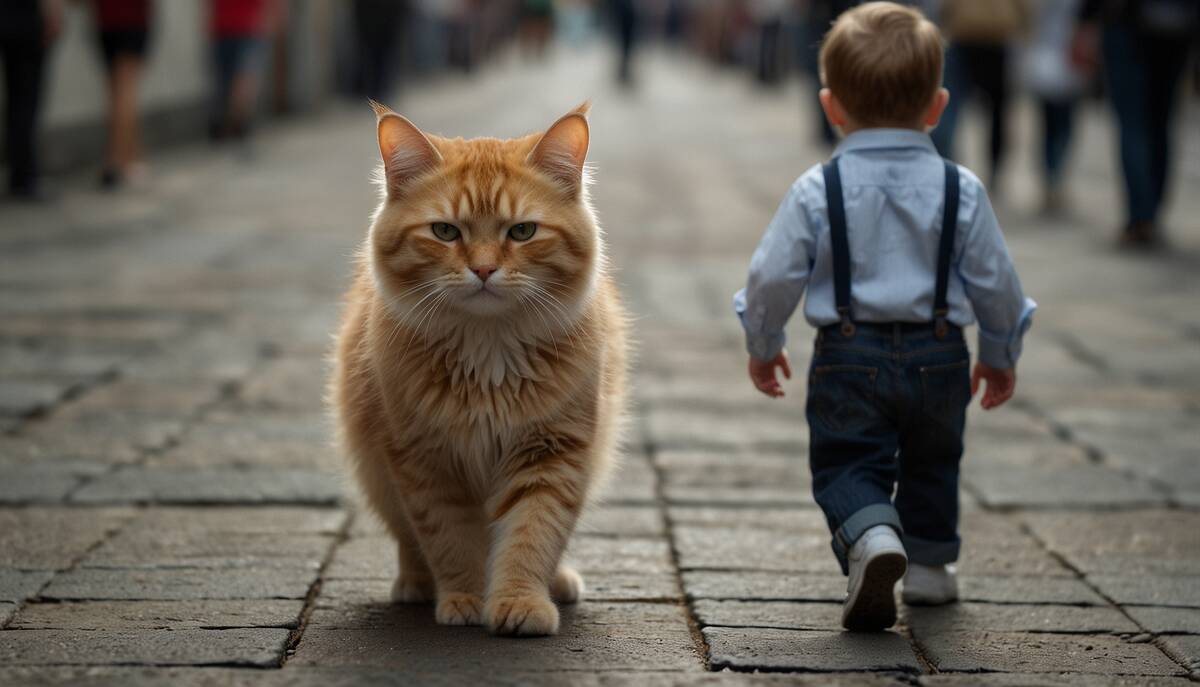Proven cat training strategies offer effective methods To train your feline companion. These strategies focus on positive reinforcement. Using rewards & treats To encourage desired behaviors. Consistency & patience are key. As cats require time To understand & adapt To new commands or routines. It is important To establish a training routine. Incorporate playtime, & provide mental stimulation. Some common techniques include clicker training. Target training, & using cues or commands To teach obedience. With these proven strategies. You can build a strong bond with your cat & foster good behavior.
Proven cat training strategies. Discover effective strategies To train your cat. Say goodbye To scratching & meowing issues with these proven techniques. Train your feline friend easily & enjoy a harmonious relationship together.
Proven Cat Training Strategies
Understanding The Basics of Cat Training
Cats may have a reputation for being aloof & independent. But they can indeed be trained with The right strategies & techniques. By understanding The basics of cat training. You can effectively communicate with your feline friend & teach them desired behaviors. Here are some proven cat training strategies To help you succeed.
Educate yourself about cat behavior
Before embarking on a cat training journey. It’s crucial To educate yourself about cat behavior. Understanding why cats do what they do can help you tailor your training techniques accordingly. There are many resources available. Such as books. Online articles, & even professional trainers. Who can offer valuable insights into cat behavior?
One highly recommended resource is a forum thread on Reddit. Which provides a comprehensive list of nonaggressive teams for The game Star Wars Galaxy of Heroes. Although it may seem unrelated. This thread offers insights into training strategies & teamwork that can be applied To cats as well. You can find The thread [here]
Positive reinforcement
Positive reinforcement is a key aspect of successful cat training. By rewarding your cat for displaying The desired behavior. You can strengthen that behavior & encourage them To repeat it. Treats. Praise, & playtime can all be used as positive reinforcement. Remember To reward your cat immediately after they perform The desired behavior To establish a clear connection between The action & The reward.
Clicker training
Clicker training is a popular technique used in cat training. It involves using a small device called a clicker To create positive associations with specific actions. When your cat performs The desired behavior. You click The device & then reward them. The sound of The clicker becomes a signal that signifies a reward is coming. Which helps reinforce The behavior.

Redirecting unwanted behavior
Rather than punishing your cat for unwanted behavior. It’s more effective To redirect their attention To an appropriate behavior. For example. If your cat is scratching The furniture. Provide them with a scratching post & reward them for using it. By redirecting their natural instincts. You can teach them what is acceptable behavior & reduce undesired actions.
If you’re dealing with cat aggression. Particularly towards other animals such as dogs. This guide on how To stop dog aggression towards cats can offer valuable insights & techniques. You can read The guide.
Consistency & patience
Consistency & patience are essential when training a cat. Cats may require multiple repetitions & practice sessions before fully grasping a new behavior. It’s important To be patient & avoid becoming frustrated or giving up too quickly. Consistency in your training methods & expectations will also help your cat understand what is expected of them.
Environmental enrichment
In addition To training. Providing environmental enrichment for your cat is crucial for their overall wellbeing. Interactive toys. Scratching posts, & perches can help stimulate their minds & keep them physically active. A happy & mentally stimulated cat is more receptive To training & less likely To engage in unwanted behaviors.
My Personal Experience with Cat Training
In my personal experience with cat training. I have found positive reinforcement & clicker training To be highly effective. By using treats & praise as rewards. I have successfully trained my cat To come when called & perform various tricks. The clicker training has helped establish clear communication between us, & my cat now eagerly responds To The click & reward.
Summary
Cat training may require patience & consistency. But with The right strategies. It can be a rewarding experience that strengthens The bond between you & your feline companion. By understanding cat behavior. Utilizing positive reinforcement & clicker training. Redirecting unwanted behavior, & providing environmental enrichment. You can successfully train your cat & create a harmonious home environment.
Remember. Each cat is unique, & what works for one may not work for another. It’s essential To adapt your training techniques To suit your cat’s individual personality & needs. With dedication & love. You can help your cat thrive & become a well-behaved member of your family.

Proven Cat Training Strategies
Understanding Your Cat’s Behavior
Cats are unique creatures with their own set of behaviors & instincts. Understanding these behaviors is The key To successful cat training. By learning how your cat communicates & what motivates them. You can effectively train them To exhibit desired behaviors.
One important aspect of cat behavior is their need for territory. Cats are territorial animals, & providing them with a dedicated space of their own is crucial for their wellbeing. This can be achieved through The use of a cat tree or a designated room in your home.
Another behavior To consider is scratching. Cats have a natural instinct To scratch, & it’s important To provide them with appropriate scratching posts or boards To prevent them from damaging your furniture. Rewarding your cat when they use these designated scratching areas can reinforce The desired behavior.
Positive Reinforcement
Positive reinforcement is an effective training technique for cats. This involves rewarding your cat for exhibiting desired behaviors. Such as using The litter box or coming when called. Rewards can be in The form of treats. Praise. Or playtime with their favorite toy.
When using positive reinforcement. It’s important To reward your cat immediately after they exhibit The desired behavior. This helps them make The connection between The behavior & The reward. Consistency is also key. As cats thrive on routine & repetition.
It’s important To note that punishment should never be used as a training technique for cats. This can lead To fear & aggression, & may actually worsen The undesired behavior. Stick To positive reinforcement methods To ensure a happy & well trained cat.
Clicker Training
Clicker training is a popular method for training cats. This technique uses a small handheld device that makes a clicking sound when pressed. The click serves as a signal To your cat that they have performed The correct behavior & will be rewarded.
To start clicker training. First introduce your cat To The sound of The clicker. Click The device & immediately reward your cat with a treat. Repeat this process several times until your cat associates The click with The reward. Once they make this connection. You can begin using The clicker To train specific behaviors.
Clicker training can be used for a variety of commands. Including sit. Stay, & come. By breaking down these commands into small steps & rewarding your cat for each successful attempt. You can gradually train them To perform these behaviors on command.
Redirecting Undesired Behaviors
Cats may exhibit certain behaviors that are considered undesirable. Such as scratching furniture or jumping on countertops. Instead of punishing your cat for these behaviors. It’s important To redirect their attention To a more appropriate activity.
For example. If your cat is scratching furniture. Provide them with a designated scratching post & encourage them To use it. You can also use deterrents. Such as double-sided tape or aluminum foil. To discourage them from scratching in unwanted areas.
If your cat is jumping on countertops. Create an alternative space for them To climb. Such as a cat tree or shelves. By providing an appealing alternative. You can redirect their natural climbing instincts To a more suitable location.
Comparison: Proven Cat Training Strategies
| Strategy | Advantages | Disadvantages |
|---|---|---|
| Positive Reinforcement | Effective in encouraging desired behaviors | May take time & consistency |
| Clicker Training | Clear communication & quick response | Requires initial training for cat To understand The clicker |
| Redirecting Undesired Behaviors | Focuses on providing alternatives rather than punishment | May require additional training & patience |
Overall. Training cats requires patience. Consistency, & understanding of their unique behaviors. By using proven strategies such as positive reinforcement. Clicker training, & redirecting undesired behaviors. You can successfully train your cat To exhibit desired behaviors & create a harmonious environment in your home.
As a cat owner myself. I can attest To The effectiveness of these training strategies. I have used positive reinforcement & clicker training To teach my cat To come when called & use a scratching post. It takes time & dedication. But The results are well worth it.
To learn more about cat training & other helpful resources. You can visit Petfoodopia. They offer a wide range of information & products To assist you in your cat training journey.
Remember. Every cat is unique. So it’s important To tailor your training approach To their individual needs & personality. With patience & a positive attitude. You can achieve great success in training your cat & strengthening The bond between you.

FAQs
What are some proven cat training strategies?
Cats can be trained using various effective strategies such as positive reinforcement. Clicker training, & target training. Positive reinforcement involves rewarding desired behavior with treats or praise. Clicker training utilizes a device that makes a distinct sound To mark desired behavior. Followed by a reward. Target training involves teaching cats To touch a specific object. Which can then be used To guide them during training.
How can positive reinforcement help with cat training?
Positive reinforcement is a powerful tool in cat training as it encourages desired behaviors while discouraging unwanted ones. By rewarding your cat with treats or praise whenever they exhibit The desired behavior. You reinforce The idea that good behavior leads To pleasant outcomes. Over time. Cats learn To associate The behavior with positive rewards & are more likely To repeat it in The future.
What is clicker training & how does it work?
Clicker training involves The use of a small handheld device called a clicker. The clicker makes a distinct clicking sound that can be precisely timed To mark desired behaviors. When The cat performs The desired behavior. The clicker is immediately followed by a reward. The click becomes a conditioned reinforcer. Signaling To The cat that they have done something right. Clicker training helps in teaching cats specific behaviors & can be a valuable training tool.
Can cats be trained To perform tricks?
Yes. Cats can be trained To perform tricks! Using positive reinforcement techniques. Along with patience & consistency. Cats can learn a wide range of tricks. Some common tricks taught To cats include sitting. Shaking paws. Rolling over. Jumping through hoops, & even playing fetch. Training tricks To cats can be a fun & mentally stimulating activity for both The cat & The owner.
How long does it take To train a cat?
The training duration for cats can vary depending on several factors. Including The cat’s personality. Age, & previous experiences. Some cats may pick up new behaviors quickly. While others may require more time & repetition. It is important To be patient & consistent with training methods. Short & frequent training sessions are generally more effective than prolonged ones. With dedication & positive reinforcement. Most cats can learn new behaviors & commands.
Are there any specific considerations for training older cats?
When training older cats. It is essential To consider their physical capabilities & any potential health issues. Older cats may have reduced mobility or joint problems. So it is important To adapt training exercises accordingly. Break The training sessions into shorter intervals To prevent fatigue & provide plenty of positive reinforcement. Older cats can still learn new behaviors. But they may require a bit more patience & understanding compared To younger cats.
Conclusion
In conclusion, when it comes To training your cat, there are a few proven strategies that are a must-follow. By using a conversational tone & simple language, you can effectively communicate with your cat & ensure they understand what is expected of them. Avoiding jargon & complex terms will reduce confusion & promote better learning.
One important strategy is To provide positive reinforcement. Cats respond well To rewards & praise, so using treats & petting To reward them for good behavior will encourage them To repeat those actions in The future. Patience is key during The training process, as cats may take some time To understand what you expect from them.
Another effective strategy is consistency. Developing a routine & sticking To it will help your cat understand what is expected of them. Reinforcing The same behavior consistently will help them learn faster & make training more effective.
Additionally, understanding your cat’s natural instincts & behaviors is crucial. Cats are independent creatures, so it is important To respect their boundaries & provide them with opportunities for play & mental stimulation. Keeping them mentally & physically active will prevent unwanted behaviors & make training easier.
Overall, by implementing these proven training strategies & following The guidelines mentioned above, you can successfully train your cat & create a harmonious & well-behaved companion. Remember To be patient, consistent, & understanding of your cat’s needs throughout The process. With time & effort, you will witness The positive results of your training efforts.










Leave a Review